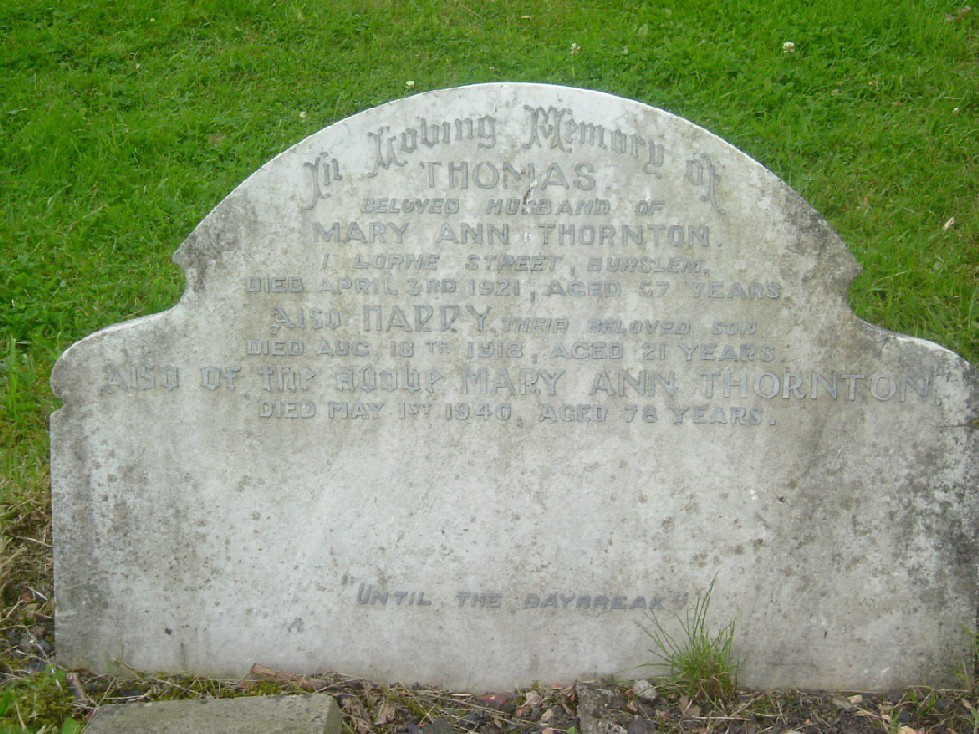- See Harry Thornton’s entry on the Board of Trade’s Ancestry public tree.
- This information updates the group’s previous research published on the former DTI website (now archived by the National Archives).
- Do you have any more information about Harry Thornton? If so the War Memorial Research Group would love to hear from you
Name recorded on Board of Trade Memorial: H. Thornton
Born: 25 January 1897
Date of Death: 18 August 1918
Age at death: 21
Service, Regiment, Corps, etc: Royal Army Service Corps
Unit, Ship, etc: Base MT Depot
Enlisted: Burslem
Rank: Private (Service No: M/286216)
Decorations: WW1 Service Medals (Victory Medal and British War Medal)
War (and theatre): WW1 (Italy)
Manner of Death: Died in Burslem from pneumonia
Family Details: Son of Thomas J and Mary A Thornton, 1 Lorne Street, Burslem, Staffordshire
Residence: Burslem, Staffordshire
Home Department: Board of Trade – Labour Department (West Midlands)
Civilian Rank: Labour Exchange Clerk
Cemetery or Memorial: Stoke-on-Trent (Burslem) Cemetery (Block 7,Row 14, No 9 also known as grave no 13023); Board of Trade War Memorial; Memorial to the Staff of the Ministry of Labour, Caxton House, Tothill Street, London
Biography:
Harry Thornton was born in on 25 January 1897 in Burslem, Staffordshire. His father was Thomas John Oliver Thornton (1864-1921) and his mother was Mary Ann Ballard (1862-1940). He had one brother also called Thomas John Oliver Thornton (1891-1948) like his father and six sisters – Kate Thornton (1881-?), Edith Thornton (1886-1963), Louise Thornton (1890-1890), Florence Thornton (1893-1969), Kate Emily Thornton (1899-1900) and Sarah Ann Thornton (1900-1988). His father was a locksmith or tinsmith.
In the 1901 census, the Thornton family are living at 63 Lyndhurst Street, Burslem and then 10 years later in the 1911 census, they are living at 14 King Street, Burslem. By 1911, Harry is aged 14 and working as a Clerk. He later joined the local Burslem Labour Exchange (as part of the Board of Trade).
During WW1, Harry served as a Private in the Army Service Corps (ASC) which was renamed the Royal Army Service Corps on 27 November 1918. The prefix ‘M’ to his military service number indicate that he served as a lorry driver in the mechanical transport regimental unit.
We also know from his medal care that he served at a Base Depot. These were set up at the French channel ports and other overseas communication hubs in other areas of war and there main communication hubs with the purpose of organising soldiers, storing and organising ammunition and other supplies, and acting as a transport hub. The hubs were operated by the ASC who were responsible for keeping the army supplied with provisions.
Although we have not yet found a photo of Harry, we are lucky that his military service attestion papers survive (being one of roughly about only a quarter to have survived after most of the papers were burnt during WW2 bombing raids). From this record we know a fair amount of information, including that he attested as a Private on 10 December 1915. He was mobilized and posted overseas on 31 January 1917 initially to Belgium and then travelled overland to Italy were he served at the Base MT Depot.
In 1915, during WW1, Italy signed the secret Treaty of London and fought alongside the Triple Entente of Britain, France and Russia. Italy became a major but often forgotten area of war during WW1 as the Allies and Italians fought against Austria-Hungary in northern Italy. The Italian Front saw difficult trench warfare, like the Western Front in France, with the added complication of fighting at high altitudes and in bitter cold.
Whilst not a frontline military serviceman, Harry’s work in the ASC would have been risky as well as mundane. Its likely he would have served at either the port or one of major rail hubs where supplies were brought from France.
Harry died aged 21 on 18 August 1918 whilst home on leave from Italy ahead of the last major British advance of the campaign that was to happen in October 1918. We know from a newspaper report in his military file that “the late Pte. Thornton came home for a fortnight’s leave, after an absence of 18 months on Friday, the 9th inst., and was due to return to Italy tomorrow. Following the extreme change of climate and a rather long and rough journey home pneumonia developed and after a few days of unconsciousness he passed away on Sunday evening.”
Harry’s character was described as “of a reserved, yet earnest disposition, and was very popular and many letters of condolence have been received by his sorrowing father and mother, Councillor and Mrs T. Thornton.” The newspaper article detailed the full list of mourners and floral tributes and detailed teh hymns sung. We also know that more than 20 members of the New Zealand Rifle Brigade attended the funeral and the officer in charge carried the deceased soldier’s pith helmet”.

Harry is buried in Stoke-on-Trent (Burslem) Cemetery where there are a total of 130 Commonwealth War Graves. He is also remembered by the Burslem War Memorial which commemorates all those from the town who served in WW1 and WW2.
In the words of Harry’s gravestone – we remember ‘until the daybreak’.
